The mentality of speculating in currencies must be good. Don't have your blood pressure soaring when there is a big drop, and don't be overjoyed when there is a big rise. It is important to put the money in your pocket. When I first started speculating in currencies, I used to worry about not being able to sleep and often woke up in the middle of the night. Now I am much calmer.
In the end, the difficulty in making money is not the skills, but the practice of my own set of secrets, which alone eliminates 70% of people. K-line patterns that crypto players must know!
1. T-shaped line (Dragonfly)
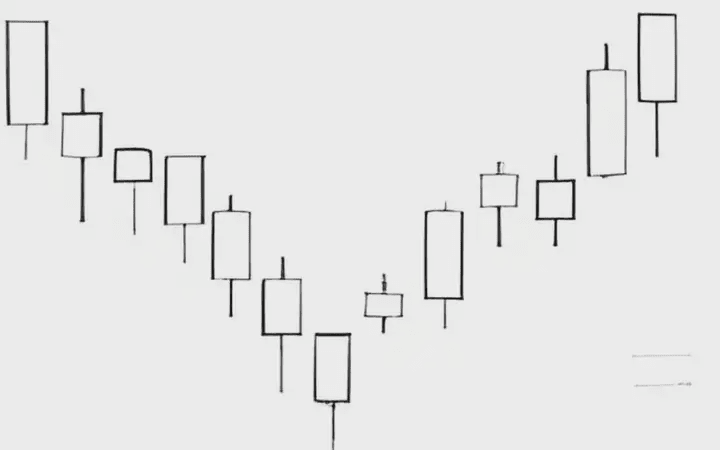
· Application rules:
Reversal lines that are bullish at the bottom and bearish at the top.
2. V-shaped reversal
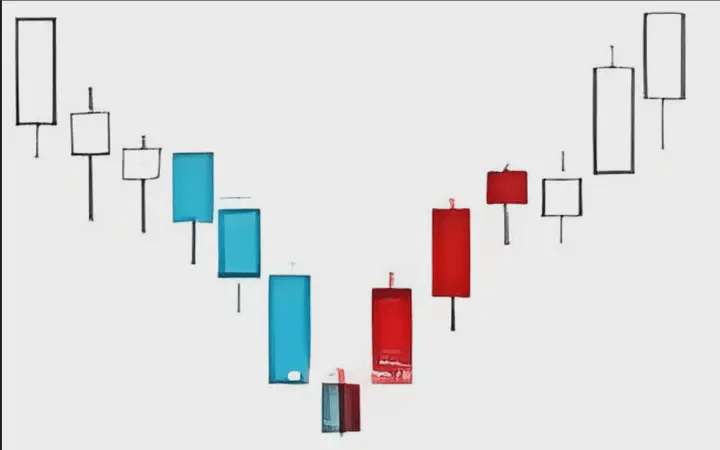
· Application rules:
Bottoming out and reversing upward.
3. Long upper shadow line
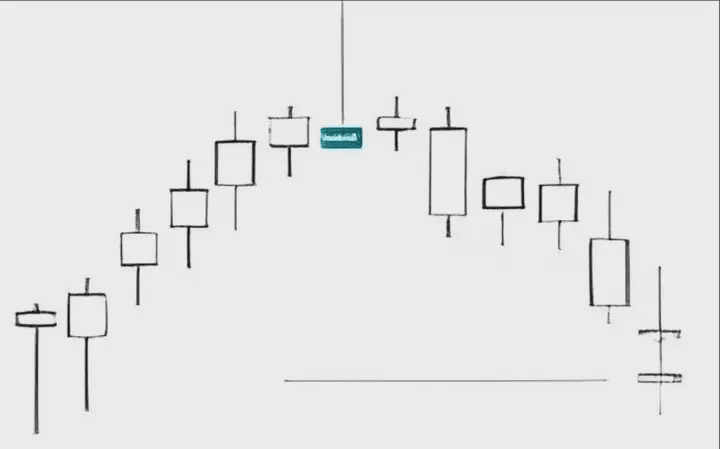
Application rules:
1. The long upper shadow line appears at the high position of the upward trend. If the trading volume increases, it means that the bulls are actively chasing the high, but the high position selling pressure is heavy, and the stock price is difficult to climb upward. The market is likely to turn back or reverse.
2. The long upper shadow line appears at the low position of the downward trend. If the trading volume increases, it means that the bulls' bottom-hunting orders have intervened, but they cannot effectively curb the selling pressure. The long and short sides have gradually turned to evenly matched.
4. Long cross line
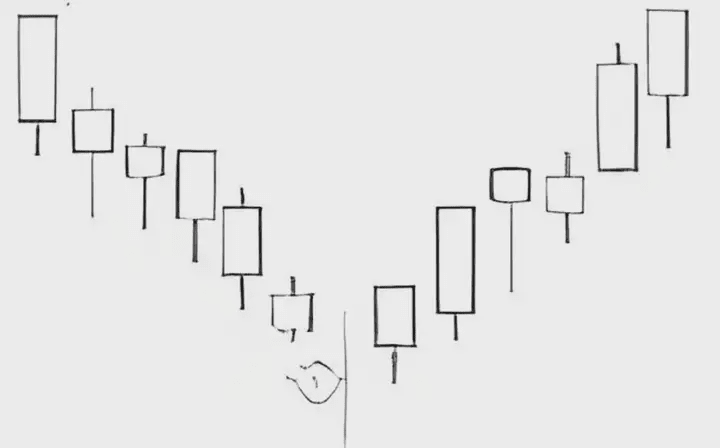
· Application rules:
1. The cross line may constitute an important warning signal. The original trend pauses or reverses.
2. The cross line is only significant if it does not appear frequently in a market.
3. If it has a very long upper shadow line, or a very long lower shadow line, it means that the market is more hesitant, and it is more predictive of the pause or reversal of the original trend than the ordinary cross line. Bottoming out and reversing upward.
5. Long lower shadow line
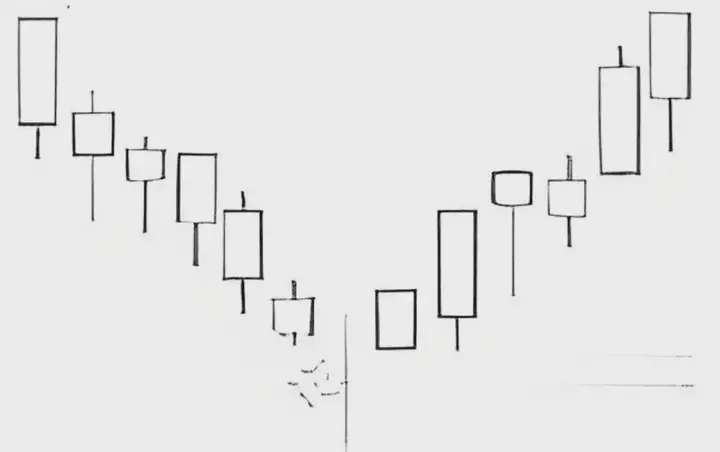
· Application rules:
1. The long lower shadow line appears at the high position of the upward trend. If the trading volume increases, it means that the selling pressure increases, and the undertaking is active, but the bulls feel exhausted.
2. The long lower shadow line appears at the low position of the downward trend. If the trading volume increases, it means that panic chips are thrown out, but the low position is actively taken over, and a large number of bulls' bottom-hunting orders intervene.
6. Lotus Emerging from Water
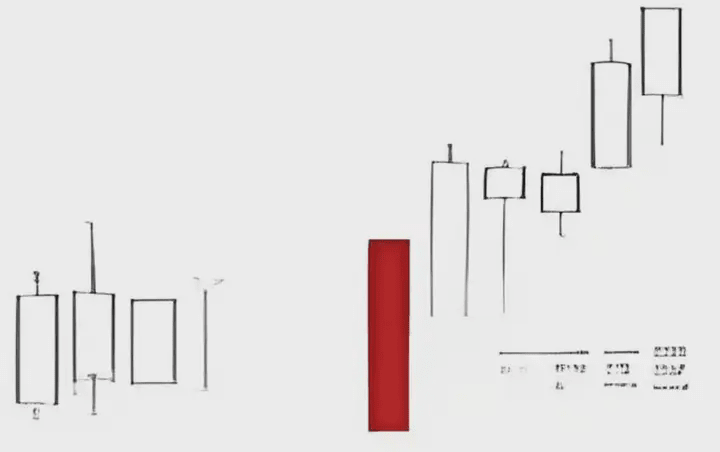
· Application rules:
A large positive line penetrates three moving averages, changing the moving averages to bullish arrangement, and the subsequent trend is bullish.
Look at the trend in the big cycle and the entry point in the small cycle (with illustration)
Because I'm going out to sunbathe
Sunbathing to replenish calcium, so there is not much dry goods, simplify complex problems, and say no more, let's show some talent
Big cycle suppresses small cycle, small cycle guides big cycle
How exactly should these two sentences be used? Many people don't use them well and say they are useless. That's because they haven't found the method.
The big cycle suppresses the small cycle. As the name suggests, it means that you should not trade against the trend. If the big cycle is long, you should not go short. If the big cycle is short, you should not go long.
The small cycle guides the big cycle, that is to say, its trend may reverse
Let's take a look at the picture
The black line segment has a direction of rising, and the yellow line segment is now starting to pull back. At this time, we need to use the first sentence, the big cycle suppresses the small cycle, then at this time the small cycle may show a downward trend and become a short trend, which is very normal.
When the rise is particularly strong
Only a healthy pullback will go further, so this pullback will not go too far. If you want to go short, it must be shorting quickly in the current cycle of the yellow line segment
Don't think about shorting very far, after all, it is just a retracement of the black line segment. If you hold the idea of shorting very far, you will be stopped out if you are not careful.
So when should you go long? You can observe the end of the small cycle pullback and start to reverse, which means that the big cycle pullback is over.
For example, when the price breaks the high point of the small cycle in the figure, it is a warning that the price of the small cycle may start to reverse, that is, the small cycle will change from short to long
Then the price of the small cycle starts to change from short to long and breaks through the high point of the big cycle
Then in the small cycle, you are doing this long order
What is found is the reversal point of the small cycle, and the multi-head trend of the black line segment of the large cycle is also followed along the reversal point of the small cycle
This is also the small cycle guiding the big cycle. Look at the big and do the small, follow the big and also follow the small
This is also why you shouldn't trade against the trend. Many times, a small trade against the trend can cause you to miss out on more profits. The most feared thing in trading is wanting to eat everything and always being in the market. This is also the reason why many traders frequently stop losses.
In trading, you must make some trade-offs. Don't do trades you are not good at, don't trade against the trend, and try to only do one cycle
If you persevere for a period of time, the funds will definitely increase, but all the prerequisites are that you need to have your own trading method,
The order of key positions (with illustration). Trading is also a process of constant self-seeking.
Today's main sharing content is the primary and secondary order of key positions
Divided into 3 types: horizontal resistance support pressure, channel line, trend line
Then the order of these 3 key positions is:
1. Horizontal resistance support pressure
2. Channel line
3. Trend line
Below, we will use the picture case to successively recognize them
1. Horizontal resistance support pressure
Horizontal pressure support is horizontal support pressure
As shown in the figure, this kind of pressure support has the greatest relative effect
First in order
2. Channel line
About channel lines, are you really using them correctly?
When rising, the bottom is the trend line and the top is the channel line
When falling, the bottom is the channel line and the top is the trend line
In the trading process, we often use channel line overshoots. That is second only to horizontal pressure support
Below, we will get to know the last trend line
3. Trend line
There are many disputes about trend lines, and everyone draws them differently.
Several points to pay attention to when drawing trend lines: 1. 2 points are just verification and do not constitute the drawing method of the trend line. Three points in a line meet the correct drawing method of the trend line
What does it mean? Looking at the content of the picture, when the price reaches the 2nd mark, this trend is drawn, and it needs to be verified by the 3rd position
After point 3 is verified, this trend line is an effective trend line.
2. Points to note
The 2 trend lines in the figure are actually effective trend lines. Which one would you mainly use in trading?
Is it number 1 or number 2? There is actually no fundamental right or wrong, but remember one thing, trend lines also have timeliness. You can't draw a trend line and use it as the main inheritance. More importantly, the current price trend is more important.
The previous diagram analysis is complete,
Trading key primary and secondary analysis is a method used to identify and evaluate the primary and secondary factors in trading. In a trading process, there are many factors that may affect the success or failure of the transaction. By analyzing these factors in primary and secondary order, we can better understand the key points of the transaction and make more informed decisions.
and can more accurately grasp and respond to various possible risks and opportunities in the decision-making process. Through scientific and comprehensive analysis, the success rate and efficiency of transactions can be improved, thereby achieving sustainable development.
Trading is a process of constantly seeking inward
Need to exercise your trading skills
Need to exercise and learn position management
Need to learn to trade off and give up transactions that you are not good at
Need to learn patience and wait for transactions that you are good at
Need to learn to control greed, leave when you should, never be stubborn
Need to bow to the market
Need to constantly admit mistakes and correct them
Need to know that money is more important than an order
Need self-comfort and self-healing
Need simplicity
Need self-confidence
Need self-discipline
Need to shield external voices, trading requires independent thinking
Need to understand to lengthen the timeline and give up the idea of making a lot of money immediately
In the mystery of trading, the answer cannot be found in a short time, but as you grow, you will definitely find the answer.
Trading is a self-game, in this game process
You are not only doing better in trading, but also your self-internal and improvement will make you more excellent, and your life will become better.
King Currency Circle: Don't be blinded by your mentality when speculating in currencies. Trading experts share profit-making techniques!
In this world, everything can be arranged, except your heart. It doesn't matter who you lose in this world, it's okay, but you lose yourself. There will be a long and very long road ahead, and you have to walk it alone, relying on yourself and your own ability to complete it. This world will not necessarily give back because of your efforts, nor will it require others to treat you the same way you treat them. The most difficult thing for people living in this world is to maintain a sense of humility and peace, and this humility comes from inner sincerity and down-to-earth efforts.
You must believe that every person and every thing you encounter in your life has its value and significance. Some people teach you love, some things teach you growth, even if they just leave a mark on your journey, it is a valuable asset. At least at some point in the past, you understood life and you understood yourself. We might as well think this way, effort with results is exercise, and effort without results is tempering. In any case, every experience is an indispensable element in your life.
It is difficult to have a good attitude without a high-winning contract trading system and perfect money management. Don't tell me that you have a good attitude holding a losing order now. I can only say that you have reached the highest level of losing goods and can deceive yourself!
Mentality = Good money management + Winning rate > 30% trading system
Among the winners in the currency circle contract market, technology is secondary. The core of their trading is money management, risk control, and trading strategies.
The reason why they can make money is that losers do not implement, or do not strictly implement, or do not fully implement money management, risk control, and trading strategies
If technical analysis is a weapon for two armies, both sides must be evenly matched; but if one side thinks that the brave wins when two strong meet, they will go all out, risk the hail of bullets, and fight shirtless, they will definitely be defeated. They did not lose in weapons and equipment, but in not understanding defense and protection, not understanding combat strategies, and not understanding the use of forces. In our trading, it is risk control, trading strategies, and money management.
If everyone strictly, scientifically, reasonably, and comprehensively implements and follows money management, risk control, and trading strategies, technical analysis can play a role in determining the pattern of winning or losing
That is, seeing this point, winners only focus on money management, risk control, and trading strategies, and never quibble about technical analysis. Their requirements for technical analysis are very rough, which is enough for them to continue to be winners for 10 years, 20 years, and continuously. Because their vision is broad and their artistic conception is profound, which is unmatched and cannot be resisted by traders who only focus on technical analysis.
Failed traders do not understand what power is controlling the transaction and are unable to extricate themselves from the pile of technical analysis books
Another reason why losers and winners are on par in technical analysis is determined by technical analysis itself. It is a congenital shortcoming of technical analysis. For example, Dow Theory judges the trend and can only confirm that the trend is established after the market has gone 30%, and will miss the opportunity to buy the bottom and escape the top.
Technical analysis is ultimately a probability problem. No matter how good your technique is, it is only a greater chance of judgment, with a 50%-60% certainty; no matter how poor his technique is, it is only slightly worse, and the probability of winning will also be 40%-50%, which is not much different.
For example, after a trend peaks, it goes about 30% of the market. Everyone should have little disagreement about whether it is the top. Some traders with different opinions will say that it is close to the top. From the overall trend, the views are basically the same, and the differences can be ignored, and there will be no win or loss gap.
But if you intervene here with a full position or a heavy position, the problem comes: our traders participate in the trend, and the big direction can be seen correctly, but they are shaken out by small, not large adjustments and lose money, and they miss the trend in a moment of slight trance, which is very regrettable
Light orders to build a position are not afraid of making mistakes, because the loss is extremely small, it is just rubbing back and forth with the market, it can't be shaken out or driven away, and the trend has been made all the way down. Then this small position is dynamically managed, adding and subtracting positions are acted according to the situation, and a lot of money is made
The difference between the technical levels of the strong and weak sides is at most 30%. If you are confident in your high skill level and enter the market with heavy positions without implementing money management; those with poor skill levels are more inferior, try orders with light positions, and the funds are managed.
Finally, you see that those who are washed out and lose a lot of money are definitely those with high skill levels who enter the market with heavy positions; while those with slightly lower skill levels will continue to follow the trend, although the profits will not be too high. However, they widen the gap in capital between themselves and those with heavy positions. After a few cycles, one or two years, the difference between them is like beggars and rich people.
So how do you do good money management? The trading system is a prerequisite for money management. You need to understand what money management is. It is a threshold from prediction to non-prediction. You need to understand it little by little. You will naturally understand when you understand it. Before you understand it, explaining it face-to-face for ten and a half months will not have any results.
A mature trading system should include money management. Money management should not exist independently of the trading system. Remember, it should not, but not cannot. Li Jun personally believes that it is necessary to accurately understand the concepts of trading rule system and money management.
To achieve money management from risk control, for the convenience of understanding, Li Jun still uses the moving average trading system and Bollinger Bands mentioned in the previous period to explain, golden cross to open long, death cross to close long and open short
Assume that the accuracy rate of the moving average trading system is 30% and the average profit-loss ratio is 7:3. Then, without considering transaction fees and costs, the entire trading system cannot make money.
How to understand? For example, trade 100 orders, 30 orders make money, 70 orders lose money, the average profit per order is 70,000, and the average loss per order is 30,000. Of course, nothing is left after calculation
In fact, most of the trading rules and trading systems established purely on the basis of indicators can only achieve no loss
Assuming that through backtesting long-term historical data, the system's maximum loss reached 80%, then it can be said that this system not only does not make money, but also has a very high risk coefficient. A maximum drawdown of 80% is very scary
How to understand? Suppose you have one million funds, and the maximum loss is only 200,000 funds. Although the final result is that you can still earn back one million, the risk coefficient in the process is extremely high, and it can be said that it is out of control. If you encounter a terrible black swan, you may be liquidated at any time.
For a system that is risky and doesn't make much money, can it not be used at all?
Answer: Definitely not
We first look at the risk. The system's maximum drawdown is 80%. Can this risk be reduced?
Of course, if you reduce the position by half, then the overall risk coefficient will be reduced by half, and the maximum drawdown will become 40%
Then what if we reduce the position to 25%? Then the maximum drawdown will also be reduced to 20%
When we write "maximum position is controlled within 10%" as a rule in our trading system, we get a low-risk system with a maximum drawdown of less than 10% that does not make money
Note that this "maximum position is controlled within 10%" is a rule in a simple and crude money management system. This rule is mainly used for risk control
The control of trading system risk comes from reasonable money management
A digression, everyone knows that you can't operate with a full position, but most people don't know why you can't operate with a full position. The answer is here
Money management amplifies profits
For us, a low-risk but not very profitable trading system is actually not very useful. To reiterate the point, how can this system achieve a positive income?
In actual operation, changing the opening and closing rules will not change the 30% accuracy rate. We cannot change the profit-loss ratio of 7 to 3. Although it is helpless, it is not without a solution. We can change the position. If we can make the average position of profitable orders reach 10%, and control the average position of losing orders at about 5%, then we will not make a profit?
Money management almost plays the role of profit maximization here. A good money management system can turn a system that does not make money into a system that makes money, and a system that makes small money into a system that makes big money.
Opportunity is coming, assets are doubling! Follow Li Ge closely and make big money easily
Continue to pay attention to: RPL, SPELL